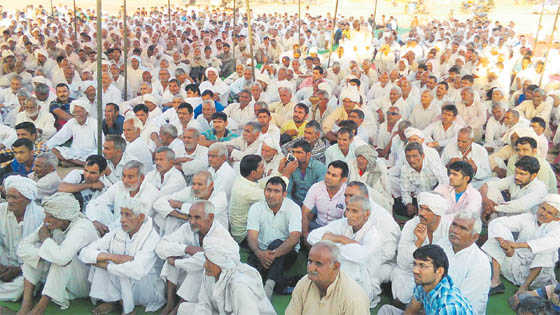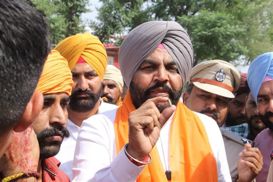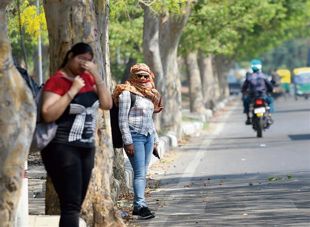
Jat activists attend the meeting organised by the all-India Jat Arakshan Sangharsh Samiti in Mokhra village of Rohtak on March 27. Tribune photo by Manoj Dhaka
M.G. Devasahayam
The Haryana cauldron continues to simmer. Responding to the Jat ultimatum to resume their agitation if their demand for quota is not met, the Haryana government invoked the National Security Act, even as it sought 100 companies of paramilitary forces to maintain law and order. The chief minister also announced a judicial inquiry to investigate the conspiracy behind the violence that rocked the state. The Jat leadership deferred the agitation and decided to wait for the promised Quota Reservation Bill but there are rumblings within the community.
Even as the state is faced with serious socio-economic discontent, the Haryana government is assiduously pursuing a "big-ticket" development model that could further aggravate the divide. The “Happening Haryana Global Investors Summit 2016” was held with much aplomb and the chief minister serenaded it as a "never-before super-successful victory." He claimed an investment pledge of Rs 5.84 lakh crore, massive indeed for the size of Haryana, which could turn the state into a land of "steel and concrete" instead of the proverbial "milk and honey"!
This elation was out of sync with the remarks made by Union Finance Minister Arun Jaitley at the summit. Jaitley described the violent Jat agitation as one rooted in inequalities within the state since 13 of its districts abutting the national capital are developing faster than the other districts: "We must bear in mind that when social challenges emerge, one of the principal reasons is inequalities between communities, between regions and different sets of people. If 53 per cent of the people involved in agriculture are getting just 14 per cent per cent of the state's GDP, that itself is an indication where the inequality has to be eliminated." Incidentally, six out of Jaitley's 13 "fast-developing districts" — Rohtak, Sonepat, Jhajjhar, Panipat, Bhiwani, Jind — themselves were among the "most violent" during the agitation. This clearly shows that the "development model" being pursued in Haryana has led to the spread of inequity and inequality throughout the state.
According to Khattar, Haryana's "lopsided" development is due to the faulty policies of the previous governments, that have resulted in glaring inequalities among regions. This is probably true, when we look at the Gorakhpur Nuclear Power Plant in Fatehabad district, actively promoted by the earlier Congress government. This 2800-MW plant on about 1500 acres of fertile land would draw 320 cusecs of water from the Bhakra Canal system. The water-use allotment for irrigation in the culturable command area being 2.25 cusecs per thousand acres, diverting 320 cusecs would deprive irrigation to 142, 000 acres of land. The polluted 30 per cent of water that would be recycled to the canal would affect downstream agriculture and slow-poison the water used for drinking by humans and animals.
The power generated in this nuclear plant would "develop" MNCs, commercial, residential, industrial complexes, malls and theme parks around Delhi, Gurgaon and other "urbanised" regions. However, in the project-affected area, agriculture will perish and radiation will cause serious damage to people, cattle and wildlife (deer/black buck) in nearby villages. Despite the people having punished the Congress party, the BJP governments in the Centre and the state continue to pursue the same "lopsided" development model with much more vigour.
The recent violent Jat stir should be viewed in this context. To recap, the Mandal Commission constituted by the Janata government in 1979 had identified Jats among the socially/educationally backward communities. The Commission's report was lying in limbo till it was revived by Prime Minister VP Singh in 1990. At that time, Chaudhary Devi Lal, the tallest Jat leader, was the Deputy Prime Minister. He and VP Singh were at loggerheads on many issues. In the event, the Mandal Commission's report notwithstanding, VP Singh deprived the Jats of the benefit of reservation. Chaudhry Devi Lal resigned and after the violent anti-Mandal agitation, the VP Singh government fell. Devi Lal again became Deputy Prime Minister in the government headed by Prime Minister Chandrasekhar and immediately instituted a Commission under Justice Gurnam Singh for the purpose. This Commission recommended the inclusion of Jats among the Other Backward Class (OBC). Hukam Singh, the then chief minister of Haryana, duly notified the same. But soon there was change in government, with Bhajan Lal (a non-Jat) as the chief minister. A PIL in the Supreme Court was filed challenging this notification and the Haryana government promptly cancelled it.
Bhupinder Singh Hooda, a Jat, became the chief minister in 2004. He is the architect of Haryana's real-estate-driven lopsided "development model" that had severely distorted the state's agrarian economy. He did nothing to deal with the spreading inequity. After nine years in office, sensing deep decline in his vote bank, he managed to get the Jats notified by the Government of India as OBC. The Supreme Court struck down the notification, thereby dealing a big blow to Haryana's Jat community.
There are nine states in the country that have Jats in the OBC category. By denying this in Haryana, the system had already played with the future of the Jat youth who were finding it hard to adjust to the new social order. Traditionally agrarian, the Jats were being gradually squeezed out of the system since the diminishing land holdings and marginal farm incomes from them had lowered their economic status. Since the economy is closely linked to the social status, they were also feeling the pinch of marginalisation. Faced with economic, social and psychological handicaps and perceiving that the new order was out to suppress them, the community rose in revolt.
The Haryana Jats, facing the massive onslaught of urbanisation and industrialisation of the National Capital Region are in doldrums. Once, their inherent pride as well as caste stigma prevented them from demanding co-listing with lower castes or Dalits. But today, faced with socio-economic distress, that stigma has eroded and they have succumbed. India perhaps is the only country in the world where castes and communities fight and indulge in violence to demean themselves as they vie to be declared backward. This is a standing testimony to the failure of the corporate, predatory and FDI-driven "development" model being pursued by successive governments.
The Haryana government's misunderstanding and mishandling of the situation has already led to serious caste polarisation. The need of the hour is a paradigm change if the simmering cauldron is not to turn into a boiler.
The writer, an IAS officer, is a former MD, HSIDC and Chief Administrator, HUDA.



























